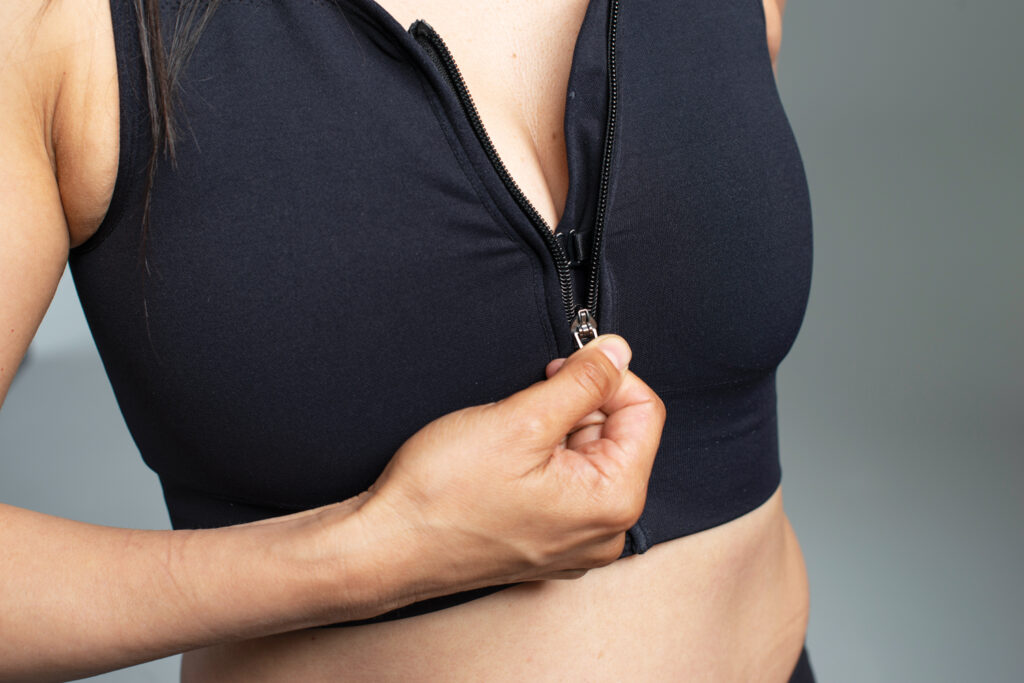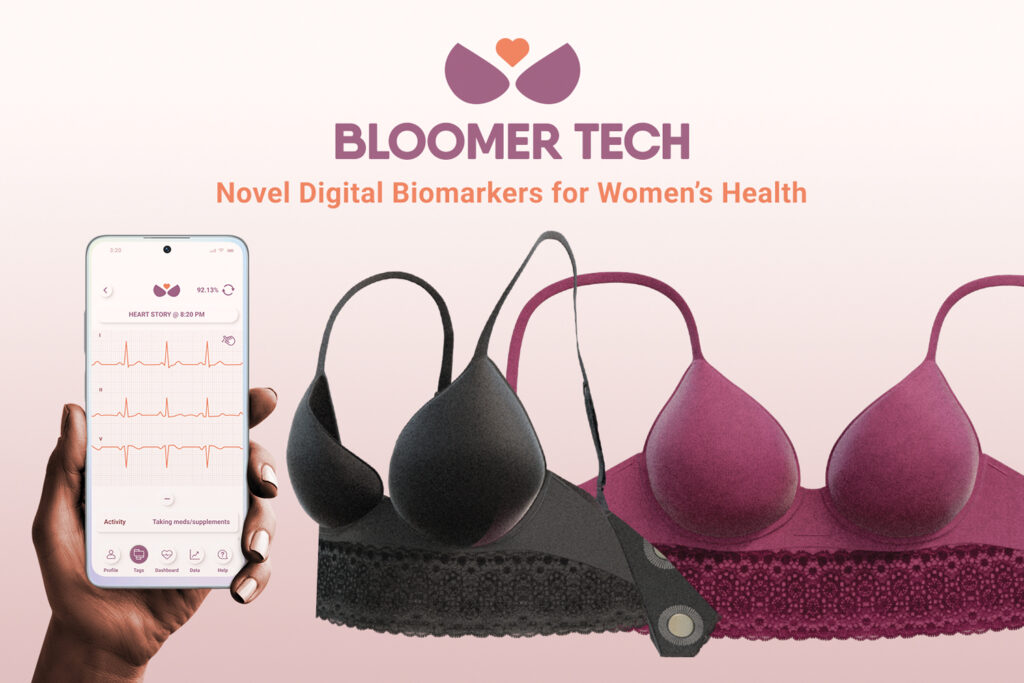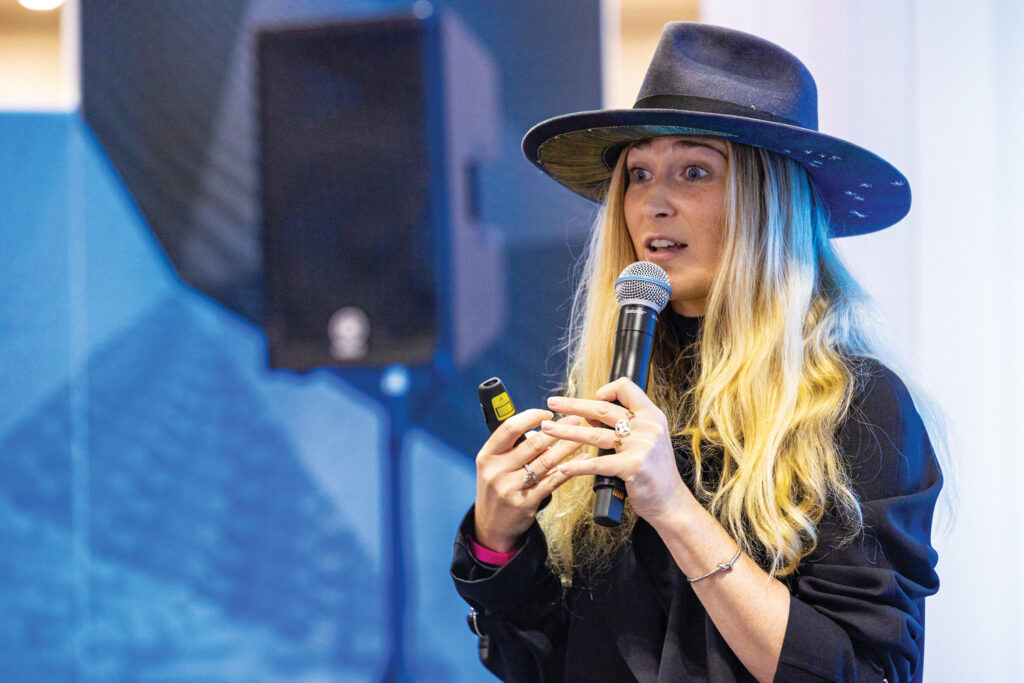
Women’s health issues have historically been underfunded and ignored, a reality that is hard to believe today considering that women make up half the world’s population. Fortunately, women entrepreneurs are working to tackle some of the most daunting medical conditions women face, and the world of textiles is leading the charge.
Prairie Wear’s post-surgical support
Holli Markwald, CEO and owner of Canadian business Prairie Wear, says, “My dream is positive global impact.” It’s evident that Markwald, who has been nominated multiple times as a Woman of Influence by the Royal Canadian Bank in Canada, is doing just that.
Prairie Wear is the maker of several sustainable bras called Huggers, designed to be better for the body and the planet. Specifically, Markwald says, “As one in eight women in North America are diagnosed with breast cancer, including women in my family, my friends and our Prairie Circle, creating a Hugger specifically for breast cancer patients is something everyone on our team felt deep in our hearts and drives us to continue to evolve our designs and company every day.”
Prairie Wear was originally focused on making sustainable, wearable sports bras but expanded its focus after a world-renowned surgical oncologist approached the company asking for a better post-surgical bra for her patients. This led to the creation of Prairie Wear’s HuggerPRIMA™, a 360-degree compression bra that can safely be worn 24 hours a day. The bra has proven to be an invaluable aid to healing in patients who have just had breast surgery and are experiencing lymphedema (a buildup of fluid) and swelling and for those who are in later post-surgical phases who want a comfortable everyday bra.
The company’s technical team members made the transition to the post-surgical bra easily through their previous work studying different performance yarns and their knowledge of seamless knits.
Markwald also contacted sports bra innovator LaJean Lawson, Ph.D., who became one of her technical designers. Lawson and the rest of the team worked with patients, athletes and professionals such as surgical oncologists and physical therapists through two years of testing to develop the HuggerPRIMA bra.
The primary material in Prairie Wear’s bras is nylon 6,6, which Markwald describes as “expensive but very good. It’s high performance—for example, it keeps its compression from the time you get up until the time you go to sleep and doesn’t change or stretch with the heat of the body. It’s also moisture wicking and antibacterial.” The bras also contain spandex for stretch. They are highly durable, so they can be thrown into the washing machine and dryer.
The bras are also OEKO-TEX® certified, which means that every component of them, from their zippers and hardware to their stitching and yarn, are certified as 100% safe for the wearer. Markwald said her decision to certify her products came out of a desire to not compromise her customers’ immune systems with chemicals that would have an adverse effect on their bodies or on the environment. “We choose all our materials based on OEKO-TEX certification,” she says, pointing out that the certification hasn’t limited her business in any way.

Bloomer Tech fights cardiovascular disease
No discussion about innovation in women’s health care would be complete without mentioning Bloomer Tech, a health care technology company named after Amelia Jenks Bloomer, a women’s rights advocate and suffragist from the 1800s who had a significant impact on women’s lives by working to replace corsets with bloomers. The Cambridge, Mass.-based company was awarded the Technology Pioneer award by the World Economic Forum in 2023 and recently received a $1.9 million grant to perform a clinical trial, the Small Business Innovation Research Direct-to-Phase II grant by the National Heart, Lung, and Blood Institute, part of the National Institutes of Health.
Speaking at a TED Talk in 2021, founder Alicia Chong Rodriguez told the audience that women had been excluded from cardiovascular research until 1993. She pointed out how cardiovascular disease presents differently in women and that this, and losing her grandmother to a heart attack in 1993 when Chong was only 13 years old, motivated her to start the company.
Chong and the company’s chief operations officer Aceil Halaby started Bloomer Tech after they both graduated from MIT in 2017. The company makes the Bloomer Bra, a medical-grade device that looks like any other bra but has embedded circuits that capture biomarkers in an effort to detect cardiovascular disease. The circuits connect to an app that allows the wearer to send information to caregivers and doctors. According to the company’s blog, it is using “novel digital biomarkers and patented textile-based sensor technology” to accomplish this.

Wearable X battles mastitis
Wearable X is a New York-based company working on a number of initiatives for women, not the least of which is a product that stimulates breastfeeding women’s milk ducts in order to avoid mastitis, which is an inflammation of mammary glands usually caused by a bacterial infection. The innovative product, a pad that can be used with an existing bra, is currently in the research and development phase.
This early prototype pad is made of breathable, moisture-wicking nylon and spandex that is both stretchable and washable. Embedded with the same type of sensors found in a smartphone, the pad “understands” the direction it is facing and contains haptic feedback motors, all of which ensures that the mother’s milk ducts are stimulated properly to avoid mastitis. The company has conducted many random consumer studies and much research to get to this stage. CEO Billie Whitehouse expects the pad to launch within the next two to five years.
Whitehouse is no stranger to taking chances in the world of design. Her original product, Fundaware, came into being after an agency approached her and told her it wanted to make vibrating underpants for couples living apart. The underwear came with an app that allows users to stimulate their partner from afar.
Whitehouse’s mother, Leanne, started the Whitehouse Institute of Design in Australia in 1988. “She certainly had a huge influence on me,” says Whitehouse, who worked for her mother for almost five years. During that time, Whitehouse researched a wide variety of areas, including personalization and customization of design. “Whether that was from a 3D printing standpoint or new technologies and sensor-based technologies like IoT [Internet of Things],” she says, “I was an idea factory!”
Whitehouse’s other well-known product is her Nadi X yoga pants. The pants have embedded sensors and are connected to a smartphone app that guides the wearer through poses using vibration and audio guidance. “I was a very active runner, but I was not flexible,” says Whitehouse, who started doing yoga because of an injury she got while running.
Whitehouse has many irons in the fire at the moment. She is looking at rehabilitation products and how they can be used in physical therapy to reduce lower back pain, particularly in pre- and postpartum women.
Quoting statistics from TechCrunch, an online magazine, Whitehouse says that women-only startups raised just 1.9% of all venture capital in 2022, down from only 2.4% in 2021. “That’s tragic and really disappointing,” she says. “I think we really need to get behind supporting young female entrepreneurs. There’s an amazing opportunity for this brilliant group of female entrepreneurs who deserve to have the attention of the venture capital market.”
Amy Farrar is a writer and editor who lives in Mound, Minn.
 TEXTILES.ORG
TEXTILES.ORG


